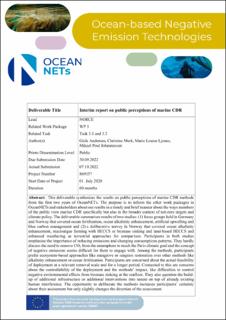| dc.contributor.author | Andersen, Gisle | |
| dc.contributor.author | Merk, Christine | |
| dc.contributor.author | Ljones, Marie Louise | |
| dc.contributor.author | Johannessen, Mikael Poul | |
| dc.date.accessioned | 2023-01-05T12:05:12Z | |
| dc.date.available | 2023-01-05T12:05:12Z | |
| dc.date.created | 2022-12-12T09:51:13Z | |
| dc.date.issued | 2022 | |
| dc.identifier.uri | https://hdl.handle.net/11250/3041215 | |
| dc.description.abstract | This deliverable synthesizes the results on public perceptions of marine CDR methods from the first two years of OceanNETs. The purpose is to inform the other work packages in OceanNETs and stakeholders about our results in a timely and brief manner about the ways members of the public view marine CDR specifically but also in the broader context of net-zero targets and climate policy. The deliverable summarises results of two studies: (1) focus groups held in Germany and Norway that covered ocean fertilization, ocean alkalinity enhancement, artificial upwelling and blue carbon management and (2) a deliberative survey in Norway that covered ocean alkalinity enhancement, macroalgae farming with BECCS or biomass sinking and land-based BECCS and enhanced weathering as terrestrial approaches for comparison. Participants in both studies emphasise the importance of reducing emissions and changing consumptions patterns. They hardly discuss the need to remove CO2 from the atmosphere to reach the Paris climate goal and the concept of negative emissions seems difficult for them to engage with. Among the methods, participants prefer ecosystem-based approaches like mangrove or seagrass restoration over other methods like alkalinity enhancement or ocean fertilization. Participants are concerned about the actual feasibility of deployment at a relevant removal scale and for a longer period. Connected to this are concerns about the controllability of the deployment and the methods’ impact, like difficulties to control negative environmental effects from biomass sinking at the seafloor. They also question the buildup of additional infrastructure or additional interventions into nature on top of already existing human interference. The opportunity to deliberate the methods increases participants’ certainty about their assessment but only slightly changes the direction of the assessment. | en_US |
| dc.language.iso | eng | en_US |
| dc.publisher | GEOMAR | Helmholtz Center for Ocean Research Kiel | en_US |
| dc.relation.uri | https://www.oceannets.eu/ | |
| dc.title | Interim report on public perceptions of marine CDR | en_US |
| dc.title.alternative | Interim report on public perceptions of marine CDR | en_US |
| dc.type | Research report | en_US |
| dc.description.version | publishedVersion | en_US |
| cristin.ispublished | true | |
| cristin.fulltext | original | |
| dc.identifier.cristin | 2091734 | |
| dc.source.pagenumber | 52 | en_US |
| dc.relation.project | EC/H2020/869357 | en_US |
